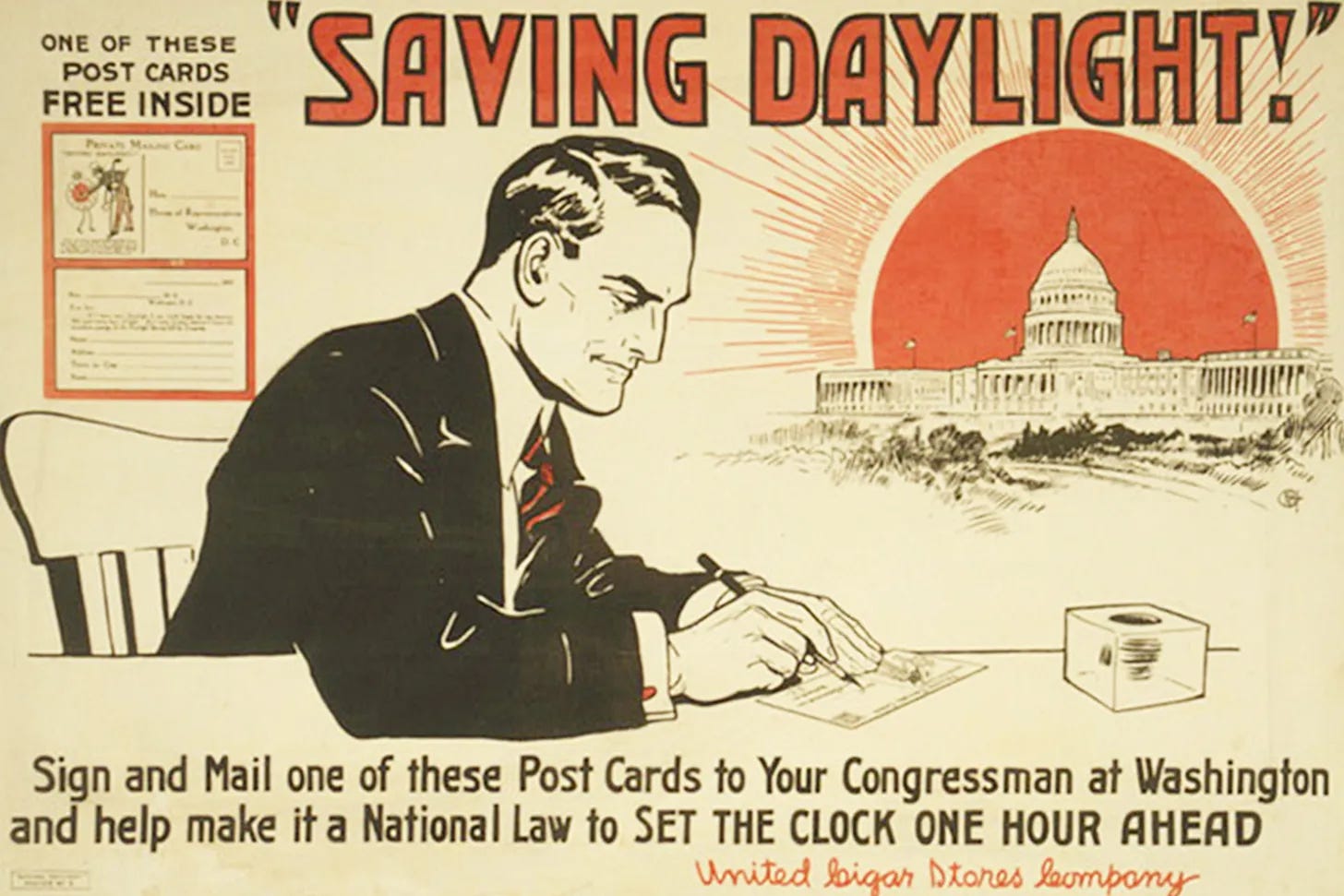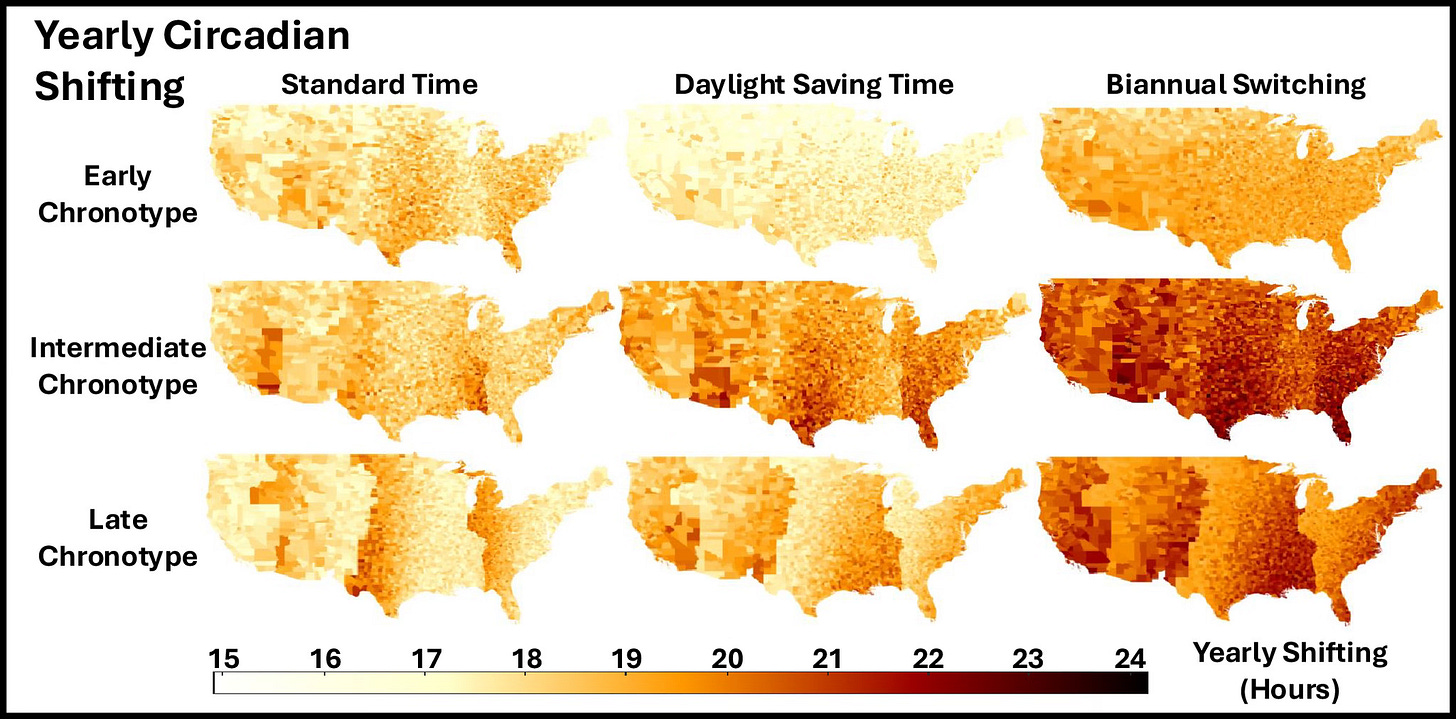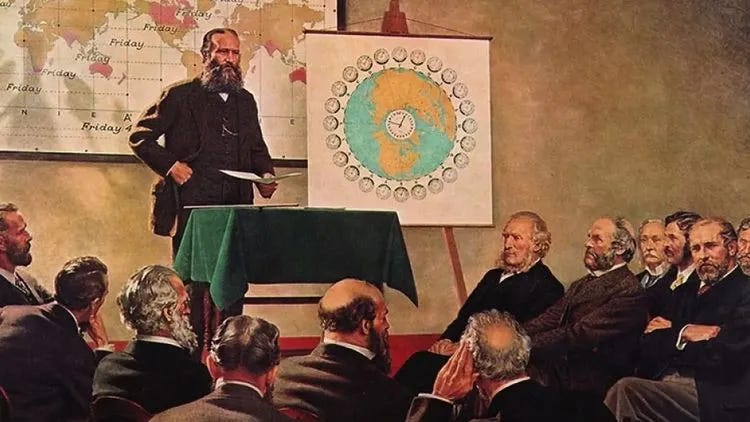Study confirms that switching to and from Daylight Saving Time is bad for our health
If you have to pick one, standard time is better than daylight saving time, but I will once again make a case for local time.
My semiannual complaint about the change in time is early this year. There is a new study, Circadian-informed modeling predicts regional variation in obesity and stroke outcomes under different permanent US time policies, which looks at the “circadian burden” of the changes.
Daylight Saving Time was first implemented in Port Arthur, Ontario (now part of Thunder Bay1) and promoted during the First World War to keep people working longer and save fuel. The United Cigar Store pushed it because they sold more smokes when there was more daylight in the evening. When George W. Bush was writing legislation to regularize DST, the time change was pushed later into the fall; “the golf industry told Congress that an additional month of DST was worth $200 million, while the BBQ industry said it was worth $100 million in extra sales of grills and charcoal briquettes.” It now falls on November 2 so that kids can trick or treat later on Hallowe’en.
Farmers, on the other hand, dislike DST because their animals don’t get it. As was noted in a discussion with John Oliver: “Of course daylight savings time doesn’t benefit farmers. Cows don’t know what time it is. Because they’re cows.”
We are not all that different from cows. I have often talked about the importance of circadian rhythms to our health, and how our bodies are tuned to the colour temperature of the light. In a previous post, I described how there are receptors in our eyes and even our skin that are sensitive to these changes.
The study authors, Lara Weed and Jamie Zeitzer of Stanford University, used “county-level circadian simulations that account for latitude, longitude, and population density and connect our results with county-level health data from the Centers for Disease Control and Prevention Places dataset to determine the circadian-related impact of time policy across the year on a variety of health outcomes.”
Latitude matters because the further north you are, the larger the seasonal shift in the length of the day. Longitude matters because it determines how far we are to one side or the other of a time zone; sunsets are later on the west side of a zone than on the east.
The “Circadian burden” is the estimate of how much our body clock time is shifted off our clock-on-the-wall time. It also varies according to our Chronotype- whether you are an early bird, an intermediate chronotype, or a night owl. As the illustration shows, the Biannual switching (BAS) had the most shifting, particularly for late chronotypes. A year-round Standard Time had the least shifting.
The authors correlated the amount of shift to various diseases and found minimal effects on the prevalence of arthritis, cancer, CHD, COPD, diabetes, or, to my surprise, depression. But there is a correlation to strokes and obesity. I had trouble understanding the numbers in the study, but Scientific American writes:
“With whole-year standard time, the study estimates U.S. obesity prevalence would drop by nearly 0.8 percent—meaning roughly 2.6 million fewer people with obesity nationwide. Stroke prevalence would also fall by about 0.09 percent, representing more than 300,000 fewer cases. Permanent daylight saving time would also help but at a lesser rate, leading to about 1.7 million fewer cases of obesity and 220,000 fewer strokes.”
Lara Weeks tells SciAm, “Our work reveals that there may be greater health benefits on a population level if we switch to a permanent standard time.” But I believe the study shows something else that is significant: look at the longitudinal shift at the edges of the time zones.
In my previous post on the subject, I noted how different conditions are from one side of a time zone to the other.
“Look at the Eastern Time Zone; In the farthest east I have been in it, Portland, Maine, sunset today is 5:39. In the farthest west I have been, Holland, Michigan, the sun sets at 6:43. In Portland, people are going home from work in the dark; in Holland, it’s light. In both places, people’s circadian clocks are out of sync with the clocks on the wall. Yet they probably have dinner and put their kids to bed at the same time, even though there is a 64-minute spread.”
I couldn’t quantify the health effects, but now I can see that a night owl in Maine has a significantly higher Circadian burden than someone in Holland, Michigan, and they are at less risk of obesity or stroke in Detroit than in Portland.
Sandford Fleming developed the concept of time zones after he missed a train. He thought there should be one cosmic or “cosmopolitan time” that would be the same for everyone everywhere- useful for scheduling trains- and a local time for each time zone. He even designed a watch to cope with two times. We got half the concept, just the time zones.
But people shouldn’t be fatter and more likely to die of a stroke in Chicago than someone across the lake in Michigan, just because they are an hour off their circadian time.
I get laughed at every time I propose it, but in light of the recent evidence, I will propose it again: Get rid of Railway Time and War Time and go Local Time.
Time zones are an anachronism. They made sense when banks opened at 10 and closed at 3, and everyone raced to catch the 5:39 train to be home for Walter Cronkite after working from 9 to 5.
Now, TV streams on demand, many people are working from home, mostly on their own schedules, and online banking and shopping have made opening and closing times meaningless. It’s a modern world where we run on Internet Time and join meetings all over the world, yet our bodies still want to tune into the sun.
That’s why it’s time to plant a stick in front of City Hall to figure out local noon and declare Toronto Time or Portland Time, or Paris Time, and schedule events in one Universal Time, or as Fleming called it, Cosmic Time, for the entire world. Our smartwatches can figure it out and show us both.
Recently on Carbon Upfront regarding circadian rhythms:
Low-E coatings on windows save energy but may be messing with our health
For many years, I have been struggling with the question: What is the purpose of a window? I have talked to so many people about this;
I am speaking in Thunder Bay on October 18, and will be adding this to my lecture!







Civilization is based upon a series of compromises including about such fundamental aspects as timekeeping. I agree that standard time all year round would be better but your local time concept makes us even more dependent upon our pocket devices not less.
I'm not sure I understand what Local Time means: measuring by the sun exactly what place in 24hrs you are standing?
And if you were 20 feet or 200 feet or 2000 feet away, it would be slightly different?
That's absurd. What would be the point of keeping time at all? Like farmers on the prairies before rural electrification; you get up at dawn and work until you can't see anymore.